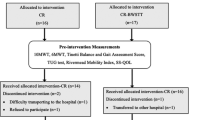Abstract
The aim of this study was to evaluate the influence of balance on the spatiotemporal features, lower-limb kinematics, and center of mass (COM) of the non-faller elderly during walking. In this study, 20 healthy elderly women (age, 76.2 ± 5.6 years; height, 150.1 ± 3.2 cm; weight, 55.8 ± 9.0 kg) were enrolled. Based on the Berg balance scale (BBS), the elderly were classified into two groups: poor balance (PB; BBS scores <46; n = 10; 43.8 ± 1.8) and good balance (GB; BBS scores ≥46; n = 10; 50.4 ± 2.5). The two groups had no differences in terms of the spatiotemporal features and range of motion (ROM) of the vertical COM (all p > 0.05). The ROM of the mediolateral COM was greater in PB than in GB. Hip transversal movements in the two groups were different. The impairment of the lateral balance function might contribute to an increase in the incidence of fall events in the elderly with poor balance.

Similar content being viewed by others
References
Rubenstein LZ. Falls in older people: epidemiology, risk factors and strategies for prevention. Age Ageing. 2006;35(suppl 2):ii37–41.
Newstead AH, Walden GJ, Gitter AJ. Gait variables differentiating fallers from nonfallers. J Geriatr Phys Therapy. 2007;30(3):93–101.
Barak Y, Wagenaar RC, Holt KG. Gait characteristics of elderly people with a history of falls: a dynamic approach. Phys Therapy. 2006;86(11):1501–10.
Chiu S-L, Chou L-S. Variability in inter-joint coordination during walking of elderly adults and its association with clinical balance measures. Clin Biomech. 2013;28(4):454–8.
Chamberlin ME, Fulwider BD, Sanders SL, Medeiros JM. Does fear of falling influence spatial and temporal gait parameters in elderly persons beyond changes associated with normal aging? J Gerontol Ser A Biol Sci Med Sci. 2005;60(9):1163–7.
Middleton A, Fritz SL. Assessment of gait, balance, and mobility in older adults: considerations for clinicians. Curr Transl Geriatr Exp Gerontol Rep. 2013;2(4):205–14.
Alexander NB, Hausdorff JM. Guest editorial linking thinking, walking, and falling. J Gerontol Ser A Biol Sci Med Sci. 2008;63(12):1325–8.
Zatsiorsky V, Seluyanov V. The mass and inertia characteristics of the main segments of the human body. In: Matsui H, Kobayashi K, editors. Biomechanics. Human Kinetics Publishers; 1983. P. 1152–9.
Hahn ME, Chou L-S. Can motion of individual body segments identify dynamic instability in the elderly? Clin Biomech. 2003;18(8):737–44.
Orendurff MS, Segal AD, Klute GK, Berge JS. The effect of walking speed on center of mass displacement. J Rehabilit Res Dev. 2004;41(6A):829.
Hayot C, Sakka S, Lacouture P. Contribution of the six major gait determinants on the vertical center of mass trajectory and the vertical ground reaction force. Hum Mov Sci. 2013;32(2):279–89.
Saunders JB, Inman VT, Eberhart HD. The major determinants in normal and pathological gait. J Bone Joint Surg Am. 1953;35(3):543–58.
Hilliard MJ, Martinez KM, Janssen I, Edwards B, Mille M-L, Zhang Y, Rogers MW. Lateral balance factors predict future falls in community-living older adults. Arch Phys Med Rehabilit. 2008;89(9):1708–13.
Choi HJ, Ko CY, Kang S, Ryu J, Mun M, Jeon HS. Effects of balance ability and handgrip height on kinematics of the gait, torso, and pelvis in elderly women using a four‐wheeled walker. Geriatr Gerontol Int. 2015;15(2):182–8
Acknowledgements
This work was supported from the research program (R7520-16-0005) by the Ministry of Science, ICT and Future Planning of the republic of Korea and the Institute of Information & communications Technology Promotion of Korea.
Conflict of interest
There are no conflict of interest.
Human and animal rights
All procedures were performed according to a protocol approved by the Institutional Review Board of the Korea Orthopedics & Rehabilitation Engineering Center (KOREC-IRB-130702-1).
Author information
Authors and Affiliations
Corresponding author
Electronic supplementary material
Below is the link to the electronic supplementary material.
Rights and permissions
About this article
Cite this article
Choi, HJ., Kim, HS., Ryu, J. et al. Variations in gait features in elderly adults during walking considering their balance. Biomed. Eng. Lett. 7, 333–338 (2017). https://doi.org/10.1007/s13534-017-0045-0
Received:
Revised:
Accepted:
Published:
Issue Date:
DOI: https://doi.org/10.1007/s13534-017-0045-0




